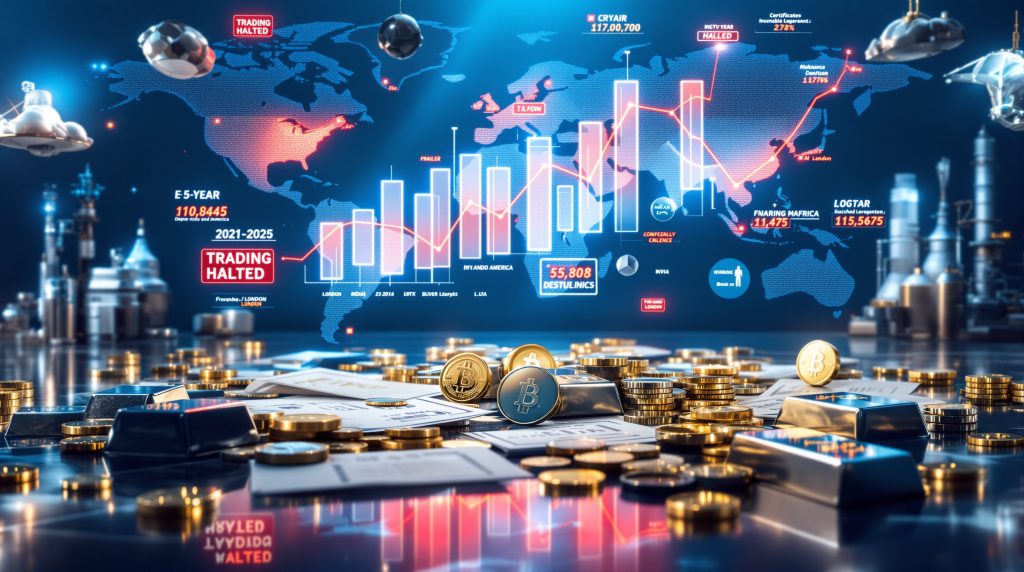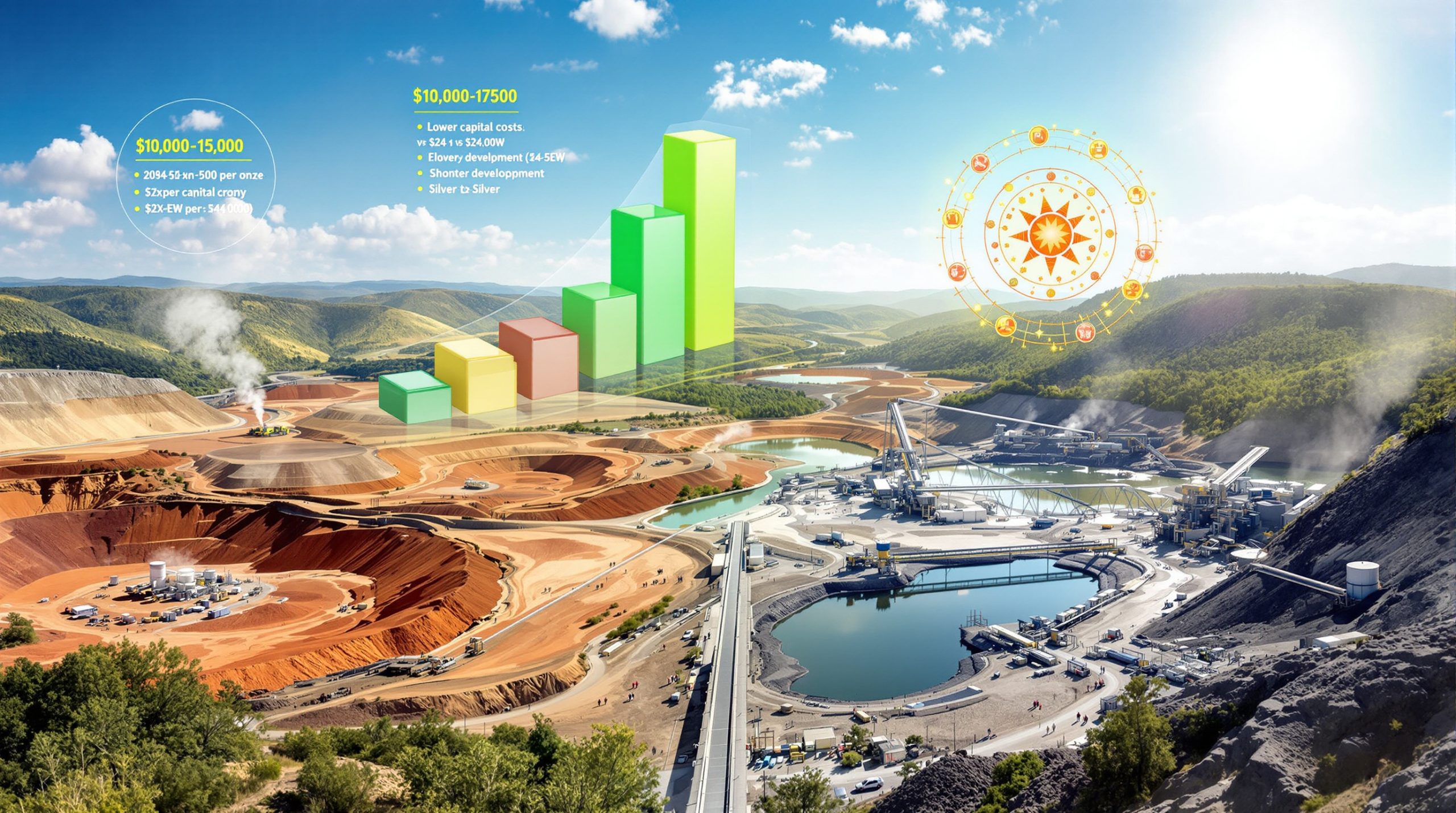Understanding the Current Silver Supply Crisis
The precious metals market faces an unprecedented disruption as physical silver shortages create widespread trading restrictions and extreme price dislocations across global markets. This crisis represents the most severe silver ETF shortages in over a decade, with industrial demand surging while mining production struggles to keep pace. Furthermore, the silver market squeeze has intensified these conditions, creating widespread disruption across investment markets.
The Scale of Global Silver Shortages
Silver markets have experienced five consecutive years of structural deficit, creating a cumulative shortage that has depleted above-ground inventories and strained physical delivery systems. This persistent imbalance stems from industrial consumption exceeding newly mined supply by substantial margins each year.
The Silver Institute reports that industrial applications now consume approximately 60% of annual silver production, with solar photovoltaic manufacturing alone accounting for nearly one-fifth of global demand. In addition, this industrial consumption pattern differs markedly from gold, where investment and jewelry demand dominates usage patterns.
Industrial Demand Explosion
Modern technology sectors drive unprecedented silver consumption rates across multiple industries:
- Solar energy infrastructure: Photovoltaic cells require high-purity silver for electrical conductivity
- Electric vehicle components: Battery systems and electronic controls utilise significant silver quantities
- 5G network deployment: Advanced telecommunications equipment incorporates silver for signal transmission
- Semiconductor manufacturing: Electronic circuits depend on silver's superior conductivity properties
- Medical device production: Antimicrobial applications leverage silver's biological properties
- Advanced automotive electronics: Modern vehicles contain increasing silver content
This industrial consumption continues expanding regardless of silver price movements, creating inelastic demand that mining production cannot easily satisfy through traditional supply responses. Consequently, silver supply deficits continue to worsen across global markets.
How Are Silver ETF Shortages Manifesting Globally?
Physical Market Stress Indicators
Wholesale precious metals dealers report unprecedented difficulties sourcing standard investment products from major government mints. Traditional delivery timelines of 4-6 weeks have been replaced by indefinite waiting periods, with some suppliers providing no estimated availability dates.
Michael Pachone, president of Can-Am Bullion, observes that major North American mints have informed wholesalers they cannot provide delivery schedules. For instance, the Royal Canadian Mint products have become extremely difficult to obtain, while US Mint availability has effectively ceased for wholesale distribution channels.
Regional Market Disruptions
International silver markets show varying degrees of stress, with some regions experiencing more severe shortages than others. Asian markets, particularly those with large industrial silver consumption, face acute supply constraints that impact both retail and institutional access.
The London Bullion Market Association (LBMA) serves as a critical benchmark for global silver pricing, yet even this established market shows signs of strain as certified inventories face pressure from increased industrial offtake and investment demand. Moreover, these disruptions have contributed to broader market instability across precious metals sectors.
ETF Trading Complications
Exchange-traded funds backed by physical silver face unique challenges during shortage periods. When physical metal becomes scarce, these funds must either suspend new share creation or trade at significant premiums to their underlying asset values.
Some regional ETF providers have implemented restrictions on new investments to protect existing shareholders from potential losses when premiums normalise. However, this represents an unusual step that highlights the severity of current silver ETF shortages across global markets.
What's Causing This Perfect Storm in Silver Markets?
Mining Production Constraints
Silver mining differs fundamentally from gold production in that approximately 70% of annual silver output comes as a byproduct of copper, zinc, and lead mining operations. This structure prevents rapid production increases in response to silver price signals, as primary metal economics drive mining decisions rather than silver prices alone.
Primary silver mines represent only about 30% of global production, limiting the industry's ability to respond quickly to shortage conditions. Furthermore, new mining projects require 3-5 years from discovery to commercial production, making supply response inherently slow.
Existing mining operations face infrastructure constraints that prevent rapid output increases even when economically justified. Processing capacity, transportation systems, and refining capabilities create bottlenecks that limit short-term production flexibility.
Investment Demand Surge
Precious metals investment demand has accelerated significantly as traditional financial assets face unprecedented monetary policy interventions. Central bank balance sheet expansion and currency debasement concerns drive investors toward tangible assets with intrinsic value.
The gold–silver ratio analysis reveals extreme divergence, which historically averaged 15-16:1 over centuries but currently exceeds 80:1. This extreme divergence suggests silver may be significantly undervalued relative to gold, attracting investors seeking ratio-based arbitrage opportunities.
Mining company stocks in the precious metals sector have generated substantial returns, with some companies achieving triple-digit percentage gains. This performance attracts institutional attention and potentially larger capital allocations to the sector.
Monetary System Concerns
Gold prices moving 4% in single trading sessions, previously considered extraordinary events, have become routine occurrences. This price volatility suggests underlying monetary system stress that typically drives precious metals demand.
"The current precious metals price action resembles patterns seen during previous monetary transitions, where asset prices disconnect from traditional valuation metrics as investors seek alternatives to depreciating currencies."
Major financial institutions like Morgan Stanley have reportedly adjusted client portfolio recommendations to include 20% gold allocation, reducing traditional bond weightings. Such institutional positioning changes could accelerate precious metals demand if implemented broadly.
Which ETFs Are Most Affected by Silver Shortages?
Physical vs. Paper Silver Divergence
The growing gap between paper silver prices and physical silver availability highlights structural issues within precious metals investment vehicles. ETFs claiming physical backing face increasing scrutiny regarding their actual metal holdings versus synthetic exposure through derivatives.
Physical silver in personal possession offers shortage protection but involves storage costs, insurance considerations, and liquidity constraints. For instance, ETF investments provide convenience and liquidity but may face restrictions during severe shortage periods.
Regional ETF Performance Variations
Different geographic markets show varying degrees of ETF stress, with some regions implementing investment restrictions while others maintain normal operations. These variations reflect local supply conditions, regulatory frameworks, and investor demand patterns.
Fund managers operating in markets with restricted physical silver access may need to implement protective measures for existing shareholders. These measures include suspension of new investment acceptance or premium trading warnings.
When Will Silver ETF Shortages Peak?
Supply Response Timeline
Mining industry analysts suggest supply normalisation requires significant time due to the nature of silver production. Since most silver comes from primary metal mining operations, increased silver prices alone cannot quickly boost production volumes.
New primary silver mining projects face lengthy development timelines from exploration through commercial production. Environmental permitting, infrastructure development, and financing requirements typically span multiple years before first silver production.
Existing mining operations may increase silver recovery rates through improved processing techniques. However, these gains occur gradually and cannot rapidly offset demand growth in industrial applications.
Demand Trajectory Analysis
Solar energy installation targets for the remainder of this decade suggest industrial silver consumption will continue growing at high single-digit to low double-digit percentage rates annually. This growth trajectory far exceeds potential mining supply increases under current production constraints.
Electric vehicle adoption, 5G network deployment, and semiconductor demand expansion create additional industrial silver consumption that shows little price sensitivity. These applications require silver's unique properties and lack readily available substitutes.
How Should Investors Navigate Silver ETF Shortages?
Physical vs. ETF Allocation Strategy
Given ETF trading restrictions and premium volatility during shortage periods, diversification between physical silver holdings and ETF exposure provides better risk management. Physical silver offers shortage protection but requires secure storage arrangements and may involve higher transaction costs.
ETF investments maintain liquidity advantages and eliminate storage concerns but may face restrictions or premium trading during severe shortage periods. Balanced allocation acknowledges both approaches' strengths and limitations. Furthermore, investors should consider reviewing an ETC investment guide to understand alternative investment structures.
Investment Timing Considerations
Traditional investment advice suggests waiting for price pullbacks before establishing positions. However, shortage-driven markets may not provide significant pullback opportunities, as physical scarcity supports price levels even during broader market corrections.
The fear of missing out (FOMO) psychology becomes evident when investors observe prices moving higher without meaningful corrections. This behavioural factor can accelerate demand and worsen shortage conditions as more investors seek positions.
Geographic Diversification Benefits
Regional ETF performance variations suggest spreading silver exposure across multiple jurisdictions and fund structures reduces regulatory and premium risk. Avoiding concentration in single-country ETFs provides protection against local market disruptions.
Different regulatory frameworks and market structures may handle shortage conditions differently, making geographic diversification a prudent risk management approach. Moreover, understanding silver market tariffs can help investors navigate potential trade-related disruptions.
What Are the Long-Term Implications of Silver Shortages?
Price Discovery Mechanism Changes
Traditional silver price formation through established futures markets faces challenges as physical scarcity disconnects paper and physical markets. This divergence could lead to structural changes in how silver prices are determined globally.
Historical precedents from the 1980 silver market provide context for understanding how regulatory interventions and trading restrictions can impact price discovery. The COMEX silver market experienced significant regulatory changes during previous shortage periods that affected long-term market structure.
Industrial Supply Chain Adaptations
Technology companies facing silver shortage constraints may accelerate research into alternative materials or more efficient silver utilisation methods. However, silver's unique combination of electrical conductivity, thermal properties, and antimicrobial characteristics makes substitution challenging in many applications.
Long-term supply contracts between industrial users and mining companies may become more common as manufacturers seek guaranteed access to essential materials. This direct relationship approach bypasses traditional commodity trading markets.
Investment Market Evolution
The silver ETF shortages crisis may accelerate development of new silver investment vehicles that address physical backing concerns. Blockchain-verified storage systems and direct mining company partnerships could emerge as alternative investment structures.
Institutional investors seeking precious metals exposure may increasingly bypass ETFs in favour of direct physical holdings or mining company investments to ensure access during shortage periods. Consequently, this shift could fundamentally alter precious metals investment landscape dynamics.
Mining Sector Performance During Silver Shortages
Mining Company Valuations
Precious metals mining companies have generated exceptional returns during the current market cycle, with some achieving gains exceeding 200% year-to-date. These performance levels attract institutional attention and potentially larger capital allocations to the mining sector.
Mining companies typically experience amplified price movements relative to underlying commodity prices, providing leverage to silver price increases. However, operational challenges, regulatory requirements, and development risks create additional investment considerations.
Production Economics
Silver mining operations benefit from higher prices but face increasing costs for energy, labour, and equipment. The net impact on profitability depends on individual mine economics and operational efficiency improvements.
Primary silver mines enjoy more direct exposure to silver price movements compared to polymetallic operations where silver represents a byproduct contribution to overall revenue streams. Furthermore, these dynamics create varying investment opportunities within the mining sector.
Regulatory and Market Structure Considerations
Historical Regulatory Responses
Previous silver shortage periods have prompted regulatory interventions in commodity markets. The 1980 COMEX silver trading restrictions demonstrate how regulatory bodies may implement measures to control extreme price volatility or speculative activity.
Current shortage conditions have not yet triggered similar regulatory responses, but the potential for intervention remains if market disruptions threaten broader financial stability or essential industrial supply chains. Moreover, market participants should monitor regulatory developments closely during this volatile period.
International Market Coordination
Global silver markets operate across multiple jurisdictions with varying regulatory frameworks. Coordination between international regulators becomes important during shortage periods to prevent market fragmentation or regulatory arbitrage.
Central banks generally hold minimal silver reserves compared to gold, limiting their ability to intervene in silver markets through reserve releases or lending programs. However, this situation could change if shortages persist and threaten economic stability.
Conclusion: Preparing for Continued Silver Market Disruption
The global silver shortage represents more than temporary market dislocation; it signals fundamental shifts in precious metals markets where decades of supply-demand imbalances manifest in acute physical scarcity. Industrial demand continues accelerating while mining supply remains constrained by structural production limitations and lengthy development timelines.
Investment demand adds additional pressure to already strained physical markets, creating conditions where traditional price discovery mechanisms face unprecedented challenges. The disconnect between paper silver prices and physical availability may persist until either demand moderates or supply increases substantially.
According to The Economic Times, investors holding silver ETFs face particularly challenging conditions during these shortage periods. Furthermore, analysts suggest that structural shortages remain intact despite temporary price pullbacks.
Investors navigating these conditions benefit from understanding the differences between various silver investment vehicles and their performance characteristics during shortage periods. Physical silver provides direct exposure and shortage protection but requires storage considerations, while ETFs offer convenience but may face trading restrictions.
The current crisis highlights the importance of diversified approaches to precious metals investment, combining physical holdings with carefully selected ETF exposure across multiple geographic markets. As shortages persist and potentially intensify, early positioning in diversified silver holdings becomes increasingly valuable for long-term wealth preservation strategies.
Market participants should prepare for continued volatility, premium fluctuations, and potential trading disruptions across various silver investment vehicles as the shortage crisis evolves through the remainder of this decade. Consequently, understanding the underlying dynamics driving these silver ETF shortages becomes essential for successful portfolio management in challenging market conditions.
Looking to Capitalise on Silver Market Disruptions?
Discovery Alert's proprietary Discovery IQ model instantly identifies significant ASX mineral discoveries across silver and precious metals sectors, delivering actionable insights that help investors position themselves ahead of market-moving developments. Begin your 30-day free trial today to gain a competitive edge in navigating volatile precious metals markets with real-time alerts powered by advanced AI technology.




